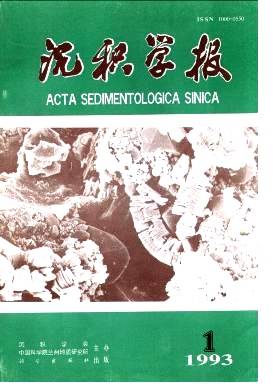Sedimentary Environments and Origin of the Devonian Oolitic Ironstones in China
- Received Date: 1991-03-16
- Publish Date: 1993-03-10
Abstract: There are 7 minerogenetic districts of middle Devonian, the important ones are the I ,II , III and IV .. and of late Devonian, V, VI, and VII. Generally, there are 2-3 girdles in one oolite, but sometimes the number can as large as 20 and as small as one , the later may be called the pseudoolites. Sometimes an oolite is a gel cumularspharolith without girdles and without nucleus and sometimes there are many girdles in oolites but without nucleus. Composition of the girdles of oolites and gel cumularspharolithes are automorphic crystals of micrograined hematite, chlorites, siderites or the mixture of the three minerals with some clay minerals (mainly is illite) , minute collphane. The nuclei are made of quartz debris in general. The matrix between oolites are made of automorphic crystal micrograined ferruginous minerals, clay minerals, minute collphane or their clastes and quartz clastes. Oolites, pseudoolites, cumularspharolithes are round, ellipsoidal in shape, 0.2-0.8mm in diameter, and all of them are in the same size. The content of oolitic ironstone TFe is 30-40% generally with the range of 27-28% to 40-46%. In China, the best sedimentary environment of Devonian oolitic ironstone is the region nearby the closed shallow water lagoon , where reserved 60% of total Devonian ollitic ironstone, the worst is the river mouth delta sand shoal, in which the ore reserve is small (only 4.2%) and ore is poor (TFe27-28) . The precursor of the oolites girdles is colloid deposits in sea water, under the condition of high energy water, the ferrugenous materials around the debris or the former colloid segration of micrograined authigenous ferro-minerals will rotate and deposite and form the girdles of ironstone oolites. Under this condition there are muclei girdles in ironstone oolites, but some oolites without nuclei only with girdles. When the sea water only with a lower energy, the gel cumularspharolith without nucleus and without girdles may be deposited.
| Citation: | Liao Shifan, Wei Lianghong, Liu Chengde, Zhang Xueshou, Ran Chongying, Shi Qingqin. Sedimentary Environments and Origin of the Devonian Oolitic Ironstones in China[J]. Acta Sedimentologica Sinica, 1993, 11(1): 93-102. |






 DownLoad:
DownLoad: